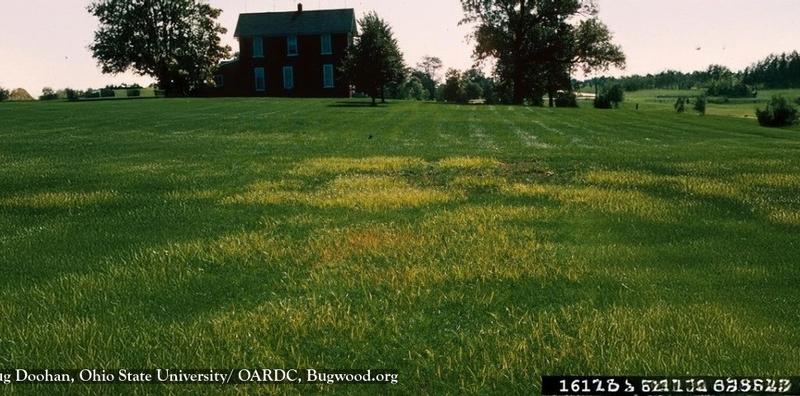Nutsedge Nightmare
Yellow nutsedge is the sneaky invader that keeps coming back, spreading underground with nutlets that survive for years. This week’s blog dives into why this glossy green menace is so hard to beat, and how to finally show it the door!
Space Invaders: Nutsedge
Yellow nutsedge is a deceptive weed. You see those bright green leaves, you bend over, you pluck them and ope! Out it comes! Easy as can be. Job done!
No.
That’s where you’re wrong.
It lives on.
You see, yellow nutsedge is a scourge in the landscape. While it looks like your average perennial weed grass, it’s much more obnoxious. Nutsedge spreads by seed, rhizome, and tubers, is tolerant of heat, drought, and flooding, penetrates the thickest of mulches, and can outcompete the plants in a planting bed. All you need is one of the little tubers in a delivery of soil, and you’ve got this headache for years. Let’s learn more about this space invader.
Meet the Invader
Yellow nutsedge, or Cyperus esculentus, is a cosmopolitan plant with a native range through North and South America, southern Europe, and Africa. This is one of those times where the common name makes a lot of sense. Cyperus esculentus is a sedge, not a grass, and its roots form storage tubers that resemble nuts. Hence, the name, nut + sedge. The easy way to identify yellow nutsedge is by its bright green, glossy, grass-like leaves, which are flat or with pronounced V-shaped midribs around a short stem grouped in threes. As nutsedge matures, it forms clumps of narrow, strappy foliage growing 4-12” long. Its pesky quality comes from how it forms colonies through rhizomes and small, starchy tubers (known as “nutlets”) that can persist in the soil for years. Later in the growing season, it will send spiky, yellow-green inflorescences in groups of three with a whorl of three bracts. While the nut is edible and used for cooking in different parts of the world (we found the plant for sale in Quebec!), a person would need a lot of nutlets to make a meal.
How To Get Rid of It
By hand
In a garden bed, we recommend removing it by hand. Using a digging trowel, hori-hori, or other implement of destruction, dig out the nutsedge, ensuring the thorough removal of the nutlets and rhizomes. The foliage pulls quite easily, but that’s the problem - the top is easy to remove, but it leaves a lot of propagation material underground, just waiting for you to walk away for it to resprout. Don’t throw the plant in the compost heap - lay it out on an impermeable surface like a road or a sidewalk and let the sun dry out the rhizome and tuber. After the plant is completely dried out, it is safe to dispose of.
Herbicide spot application
Spot treatment with a systemic herbicide can be used, but it will need more than one application. In a garden bed, it’s usually challenging to spray the nutsedge without accidentally affecting other desirable plant material. Follow the directions on the label for best practices and be sure to include a nonionic surfactant to ensure good chemical adhesion to the nutsedge foliage.
Tilling large areas
While the best organic approach is hand pulling, in larger areas such as large beds before plantings, nutsedge can be controlled and even eliminated by proper timing of tillage applications. It is recommended to either till in late spring or early summer to prevent further spread, or in late summer to prevent further tuber formation. Repeated tilling and leaving the plants on top of the ground to completely dry out in the sun will kill them. It is best to till the soil when it is dry to ensure the weeds die.
Solarization
Solarization of an infested area can be an effective treatment, but the soil temperature must exceed 113°F for a sufficient period to eliminate tubers reliably. In cooler regions or areas with shorter summers, solarization alone may not be effective. Also, beware that when the plants first emerge, the leaves form a tight spike that pierces opaque, thin horticultural plastic, rendering the solarization ineffective. To ensure the solarization works well, utilize a thicker clear horticultural plastic or a heavy landscape fabric and leave it to cook for a growing season.
Till then Solarize
The ol’ 1-2 punch. In large infestations, one can first till the planting bed in spring, exposing the rhizomes and tubers to the sun, which weakens them. Then, solarize the bed for a reliable and effective treatment. This is a very effective treatment for large, persistent infestations.
Set the Tiller on it, then Go Hog Wild!
You read that right. First, till the large planting area as described above. Then, in a secure enclosure, let loose the hogs. The delicious rhizomes and nuts are a gourmet treat for the little piggies, and they’ll root around and clean that infestation right up.
Invade no more!
Yellow nutsedge, while a persistent and adaptable weed, isn’t as bad as some of the others on the Space Invaders list. We concede that since it doesn’t poke you, sting you, or burn your skin, it’s not the worst. It’s even tasty. But in a fresh planting bed where you just installed dozens of Landscape Plugs™, it’s definitely not a welcome addition.
Learn More:
Cornell CALS Weed Science: “Yellow nutsedge”
Missouri Botanical Garden Weeds In the Garden: “Yellow nutsedge”
North Carolina Extension Gardener Toolbox: Cyperus esculentus
Previous Space Invaders:
Japanese stilt grass | Multiflora rose | Poison ivy | English ivy | Sweet autumn clematis | Mugwort
Click Here for the Email


